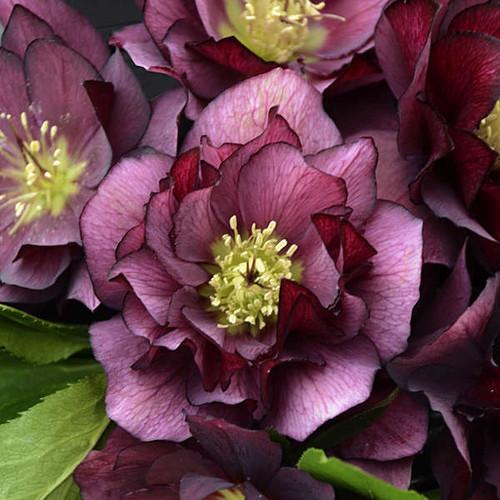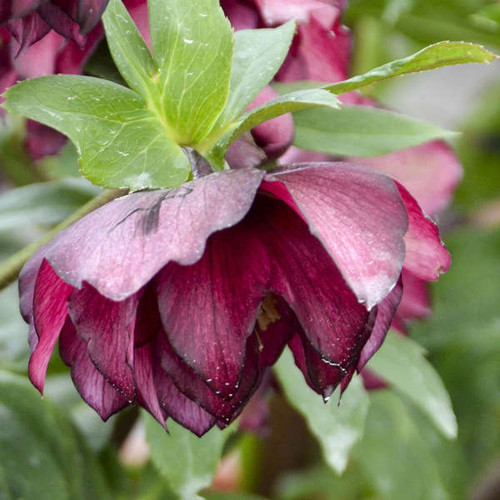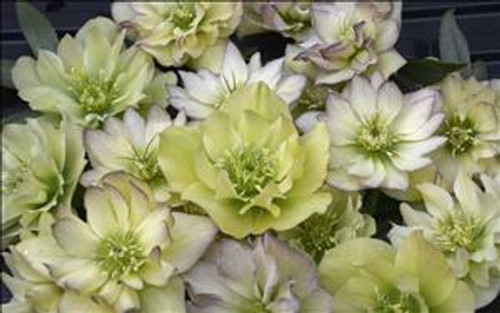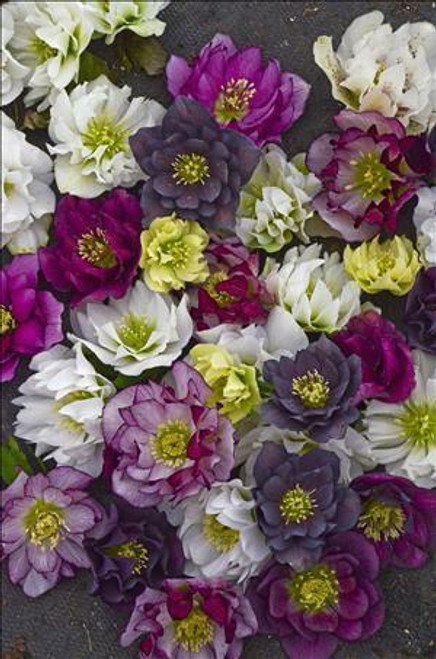Product Description
Helleborus 'Dark and Handsome' - WEDDING PARTY Series (20)ct Flat
Lenten Rose
Height: 18-24 Inches, Spread: 18-24 Inches
Flower Color: Near-black shades, Foliage Color: Green shades, Evergreen (in some or all zones)
Hardiness Zone: 4 - 9
Part shade to Full shade
Blooms Early Spring - Mid-spring
Helleborus 'Dark and Handsome' bears 2.5-3', near black to black-purple flowers. Deer and Rabbit resistant.
If you swoon over the tall, dark, and handsome, we have the Hellebore for you ! Helleborus 'Dark and Handsome' is a captivating Lenten rose with large, double, near-black to black-purple flowers that bloom heavily in early to mid-spring, bringing a touch of drama to the garden when most other plants are still dormant . This stunning variety belongs to the Wedding Party Series, known for its double-flowered selections in a wide array of beautiful colors . As part of the research for this article, several images of Helleborus 'Dark and Handsome' were found, displaying its unique beauty . 'Dark and Handsome' is a vigorous grower, reaching 18 to 24 inches tall and wide, with mature specimens producing 40 to 60 blooms per plant . Its glossy, dark green foliage provides year-round interest, making it an excellent addition to any shade garden.
- Common Name: Lenten Rose
- Botanical Name: Helleborus x hybridus 'Dark and Handsome'
- Flower Color: Near black to black-purple with lime green centers
- Flower Form: Double, cup-shaped, 2.5 to 3 inches across
- Foliage: Glossy, dark green, leathery leaves divided into 7 to 9 toothed leaflets
- Height/Habit: 18 to 24 inches tall, bushy, upright clump
- Bloom Time: Late winter through early to mid-spring (February to April)
- Bloom Duration: Eight weeks
- Hardiness Zones: 4 to 9
- Benefits for Pollinators: Hellebore flowers provide valuable nectar for early pollinators.
Planting Requirements Helleborus 'Dark and Handsome' thrives in partial shade to full shade and prefers fertile, humus-rich, moist, well-drained soil . It can tolerate a range of soil types, including sandy or clay soil, and even short periods of drought . For optimal growth, provide a sheltered location protected from cold winter winds . When planting, space hellebores about two feet apart to accommodate their spread.
Soil While 'Dark and Handsome' prefers rich, moist, organic soil, it is adaptable and can grow in sandy or clay soil as well . The soil pH should be neutral or slightly alkaline . Good drainage is essential to prevent root rot.
Sunlight Helleborus 'Dark and Handsome' is a shade-loving plant that needs protection from the hot afternoon sun . It thrives in full shade under deciduous trees, benefiting from full sun during winter and spring before the trees leaf out . Its primary growth spurt is in early spring and autumn, so it can tolerate less moisture during the summer months.
Watering Water regularly, especially during the first growing season, to establish a deep root system . Once established, 'Dark and Handsome' is relatively drought-tolerant but benefits from watering during prolonged dry periods.
Companion Plants Helleborus 'Dark and Handsome' pairs beautifully with a variety of shade-loving companions. Consider these options:
- Ferns: Japanese painted ferns (Athyrium niponicum var. pictum) offer contrasting foliage with their silver and bluish fronds . Christmas fern and Japanese shield fern are also excellent choices.
- Bulbs: Early-blooming bulbs like snowdrops, crocus, grape hyacinth, and miniature daffodils add a vibrant touch to the spring garden.
- Perennials: Woodland phlox, bleeding heart (Dicentra spectabilis), and barrenwort (Epimedium spp.) provide complementary colors and textures.
- Grasses and Sedges: Low ornamental grasses and sedges, such as Carex comans and Carex flaccosperma, add an airy texture and winter interest.
- Shrubs: Shade-tolerant evergreen shrubs like Christmas box (Sarcococca confusa) provide shelter and contrast.
Pests and Diseases While Helleborus 'Dark and Handsome' is generally a low-maintenance plant, it can be susceptible to certain pests and diseases. Some common pests include aphids, which are tiny green or black insects that feed on new growth and flower buds, and vine weevils, which can damage the plant's crown and roots . Potential diseases include black death, a virus that causes black streaks on leaves and stunted growth, and leaf spot, a fungal disease that causes brown patches on leaves and stems . To minimize the risk of pests and diseases, ensure proper growing conditions, including well-drained soil and good air circulation.
Helleborus 'Dark and Handsome' is a captivating and low-maintenance perennial that adds a touch of drama to the shade garden. Its striking near-black flowers emerge in late winter or early spring, providing a welcome burst of color when most other plants are still dormant. The glossy, dark green foliage offers year-round interest, and the plant thrives in partial to full shade with fertile, well-drained soil. To enhance its beauty and create a thriving shade garden, consider pairing 'Dark and Handsome' with companion plants such as ferns, bulbs, perennials, grasses, and shrubs. With proper care and attention to potential pests and diseases, Helleborus 'Dark and Handsome' will reward you with its unique beauty for years to come.
Other Details
The most important part of the plant is its root system. Healthy roots are the foundation of a healthy, vibrant plant. The type of plug container used is based on the specific needs of the plants. Perennials offered as bare root traditionally perform better when planted as bare root.Planted in a specialized mix, potted plants have well established root systems. Top growth stage will vary depending on the current life cycle and time of year when shipped. In Winter and early Spring dormant plants may be shipped. Dormant plants may be planted right away, even before the last frost date.
Most bare root varieties are field grown for at least one season, though Hemerocallis and Hosta are grown for two seasons. The bulk of the soil is removed during the harvesting process and the tops of most varieties are trimmed back to the crown. They are graded, packed in shredded aspen or sphagnum moss and stored in freezers until ready to be shipped.
See our Container Sizes and Bare Root Perennials pages for more information.
Plant information and care is provided in the Overview section, Plant Genus Page and general information is provided in the Planting Care & Guides. Additional questions can be asked on each Plant page.
Plant Spacing: Using the maximum mature spread or width of a plant to guide spacing, ensures space to grow to full size. To fill an area sooner, plant them closer together. Just remember, future thinning or transplanting may be needed.
Water: Keep a close eye on newly planted perennials, especially throughout the first growing year. Most early plant loss is due to too much or too little water!












